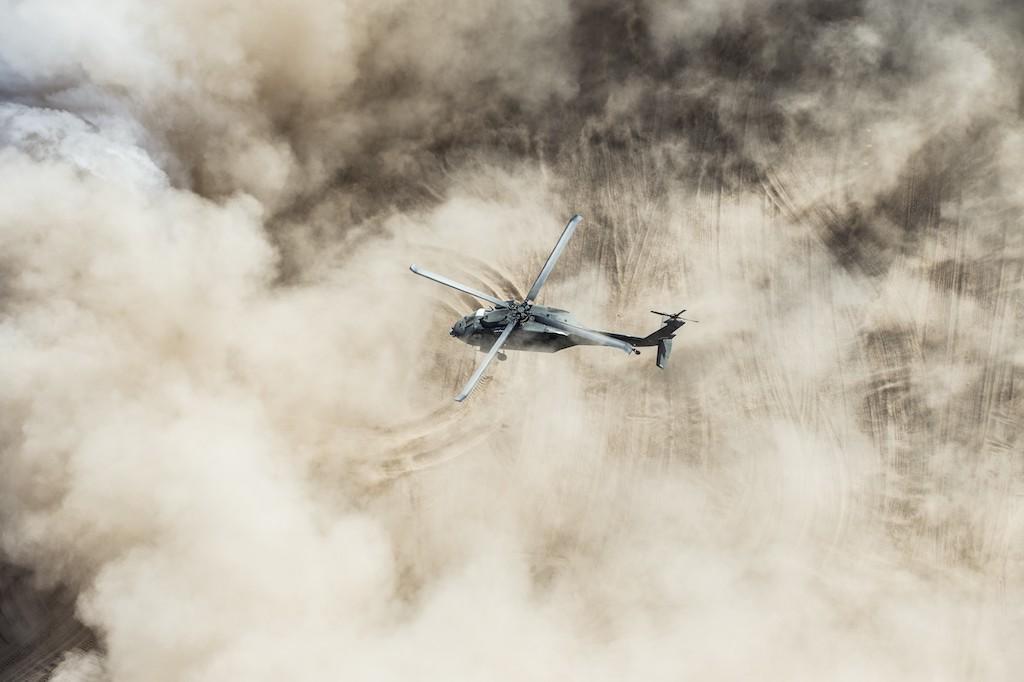Protecting Aviation Infrastructure: Are We Prepared? Part 2

Sandy/dusty operations cause multiple negative effects on turbine powerplants.
In Part 1, we discussed the effects of precipitation on airport infrastructure.
Dry conditions from drought impact water supplies in areas dependent on surface water. Additionally, droughts dry out vegetation, increasing wildfire potential and severity. The arid U.S. Southwest lives in a perpetual series of droughts, but drought conditions also may occur in places not typically perceived as drought regions.
The “Report on Effects of a Changing Climate to the Department of Defense, January 2019” document identified desertification as one of the many increased threats from climate change. Desertification results in reductions in vegetation cover, which can lead to increases in the amount of runoff from precipitation events. Greater runoff contributes to higher erosion rates, increased stream sediment loads and deposition of sediment in unwanted areas. This reduces the effectiveness of flood risk management infrastructure while increasing the potential for siltation of water supply reservoirs.
Following rain, eroded soil may be less suitable for native vegetation, resulting in bare land or revegetation with non-native, weedy species. Typically, non-native species (the most infamous example being “cheat grass”) create enhanced wildfire potential. The mere mention of “cheat grass” to professional wildland firefighters brings considerable concern. Cheat grass is highly flammable, and it provides ample, fine-textured fuels that quickly increase a fire’s intensity.
The prolonged drought in the Colorado River Basin has dropped water levels in its two major reservoirs to historic shallow depths. Engineers are warning that the turbines that generate electrical energy for the region will be unable to function if this drought continues much longer.
Sandstorms And Dust Storms
The 2019 DOD report also analyzed the likely increase in occurrence and intensity of sandstorms and dust storms caused by both longer drought periods and potentially stronger winds in the subtropical latitudes. For rotorcraft operations this will increase the occurrence of “brown outs,” a dangerous phenomenon when making landing approaches in dusty environments. Sand or dust particles become swept up in the rotor outwash and obscure the pilot’s vision of the terrain. This is particularly dangerous because pilot need those visual cues from their surroundings in order to make a safe landing.
Helicopter brownout was a $100 million-per-year problem for the U.S. military in Afghanistan and Iraq. The U.S. Army cited brownout in three out of every four helicopter accidents there.
In a thought-provoking presentation titled “What We Need to Start Designing Engines For,” Rory Clarkson, a Rolls-Royce specialist on engine environmental protection, summarizes the many threats in the airborne environment that will negatively affect engine performance, including ice crystals at high altitudes, lightning, birds, corrosive gases and aerosols, volcanic ash clouds and sandstorms.
Sandy/dusty operations have multiple negative effects on turbine powerplants. Lubricating systems can be contaminated. Support systems for electronics, heat exchangers, mechanical systems and fuel supplies can be blocked. Turbine cooling systems can suffer damage, reducing component life. Additionally, compressor blades can be eroded, leading to loss of efficiency and surge margin. Molten silicates will stick in the turbine annulus, reducing the surge margin. Both phenomena can lead to a reduction in high-pressure compressor surge margin.
Moderate rotor erosion will cause “manageable” loss of performance in the short term but likely lead to premature removal for overhaul. Severe rotor erosion or blockage of the cooling paths will require immediate maintenance action. Blocked fuel delivery or deposits of molten silicates in the turbine annulus could result in loss of controllable thrust. Pitot-static ports and conditioning packs can be clogged as well.
The additional maintenance required to prevent, as well as detect and repair, the damage from sandstorms and dust storms is extensive. It is recommended that aircraft already on the ground when a sandstorm is approaching have intakes, vents and tubes covered to prevent ingress of sand and dust. Any area where the ingress of dust could interfere with flight controls must also be covered. Before subsequent flight, all vents, intakes and tubes must be cleared of any sand or dust.
In Part 3, we’ll discuss how warming trends could increase the potential for inflight icing.
Protecting Aviation Infrastructure: Are We Prepared? Part 1: https://aviationweek.com/business-aviation/airports-fbos-suppliers/prot…





